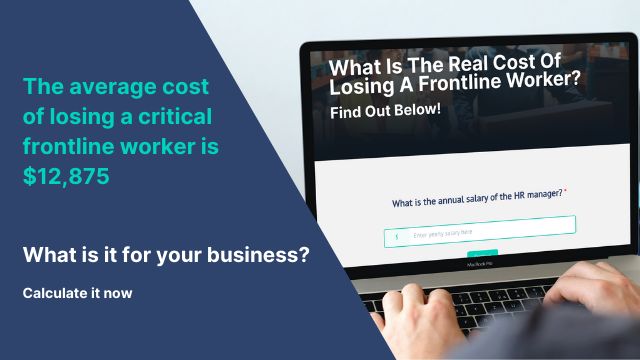Employee turnover costs: realizing the impact on frontline workers
February 3, 2022
Between new hires and existing employees, supply chain companies are experiencing high levels of frontline worker turnover. And it’s not just a frustrating process to find quality replacements, it also can also be very expensive and significantly impact a company’s bottom line.
Workforce turnover costs a company so much more than just the termed employee’s salary. There are many factors that must be taken into consideration when determining what a turnover event really costs a company. But often companies calculate that number to be much lower than the actual cost.
Here are six areas you must consider to accurately calculate your true cost of turnover:
1. Talent sourcing costs
When a position opens up it can be challenging to find the right person for the role. Companies have to invest in ways to source quality candidates. This cost can vary based on methods used for recruitment by organizations.
Some businesses work with agencies while others may have in-house talent acquisition teams or rely on human resources to perform these duties. Regardless of the method, there will always be a cost that needs to be included when determining your total cost of turnover.
Sourcing candidates, screening, and scheduling interviews for open roles can be a very arduous process. Having a solution like WorkStep HIRE eases this burden by finding great-fit applicants quickly from a talent pool specific to the supply chain. WorkStep HIRE also offers built-in screening and automated interview scheduling to help speed up the time to hire.
2. Employee salaries
When a position has been filled, the salary expenses associated with hiring, onboarding, and training then must be included in determining the cost of turnover. Obviously the hourly wage of the employee hired must be factored in, but it’s also important to add the salaries of the HR manager, the hiring manager, and the training manager to your calculations to get a true accurate presentation of your total costs per hire. Additionally, it’s important to consider the hours the hiring managers and HR team are spending to hire their frontline workers.
3. Incentive pay
As the talent pool drastically decreased for the supply chain, companies began offering incentives to remain competitive and attract new candidates. Whether offering signing bonuses, higher wages, or tuition reimbursement, significant money is required to support these hiring initiatives and therefore needs to be added to your tally. We are currently seeing the average incentive pay around $1,200 per hire.
4. Employee benefits
Part of staying competitive in a very tight labor market is offering exceptional benefits to frontline workers. But this means the cost a company has to contribute per employee will continue to rise considerably. Figuring out the amount an organization pays for each worker for benefits is another investment that should be factored into calculating the cost of turnover.
5. New employee efficiency
No matter how skilled or talented a new hire is, no one is performing at 100% efficiency on day one. In fact, only about 29% of warehouses can bring a new worker up to speed in less than a month. This means it often takes longer than a month for an employee to go through onboarding and training and have the ability to work independently. Now, consider what the cost must be during this employee’s ramp period and add that to your cost for turnover.
6. Additional talent expenses
Depending on the organization, there may be other costs associated with hiring a new candidate. These may include things like drug testing, background tests, road tests for truckers, OSHA certifications, and so on. You’ll want to add these expenses to your calculations as well.
Now you know what you should include in order to accurately figure out your real cost of turnover. So now what?
WorkStep has developed a Cost of Turnover Calculator that allows you to plug in the costs for each area mentioned above. Unsure of every amount? WorkStep provides industry averages for many fields to help you quickly get an idea of what the cost of a turnover event is for your company.
Please contact us with any questions regarding the Cost of Turnover Calculator. And if you’d like to learn more about WorkStep, which helps companies reduce turnover up to 36%, schedule a demo today!
Tune into your frontline with WorkStep
With the frontline employee engagement platform that delivers the real-time insights you need to take action, retain your workforce, and drive your business forward.
Mark Bell, VP of Marketing | markbell@workstep.com



